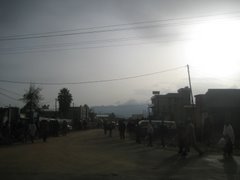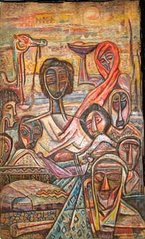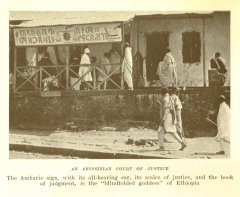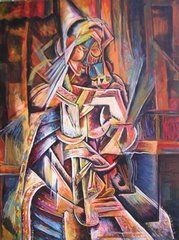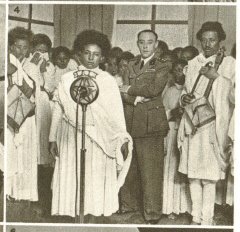The City of Addis Ababa

Addis Ababa (translates to New Flower) is the capitol city of the third most populated country in Africa - Ethiopia. The city is blooming with new construction projects arising every day. Streets are trafficked with old Volkswagens, faded Toyota's, herds of cows and sheeps, bright blue taxi-cabs, and a few shiny black Mercedes. Buses are packed air-tight: the city's people standing shoulder-to-shoulder, drowned in each other's scent. And markets are filled with chattering shop owners eager to sell their goods. The city is the urban center of the 85% rural country.
Addis Ababa was not always an urban area and moreover, it was not always the capitol city of Ethiopia. In fact, a little over one century ago, the "capitol" city was hundreds of miles north west of Addis. I put "capitol" in quotations, because in the past the capitol city did not hold as such a stable, solid political symbol as it does today. Regional governors had much political autonomy and force - most governors had armies of thousands; whereas, today the army and political power is centralized to the government in the capitol city. Back then, the political center of Ethiopia was mainly in Gondar (founded in 1636 by Fasiladas); although, at times it would temporarily relocate, reaching cities like Dabra Tabor (the center of the Yajju dynasty).
It was in the late 1800s to beginning 1900s, that the political center started its march down south. With Negus Yohannes' occupation with the Italians in the North, the Mahdist Sudanese in the West and the Egyptian/Ottomans in the East, Menilek of Shewa had the perfect opportunity to expand his influence south of the empire. So, when Yohannes died (1889) in the Battle against the Mahdist Sudanese, Menilek with few opposition rose to power.
Menilek had been expanding Ethiopia's influence to the South, which flourished with great exportable goods (i.e.coffee). So, it seemed fit to move the capitol of the empire to a new, more appropriate center. In 1881, he moved to Entotto (a little north of Addis Ababa). 
Entotto had been a resting camp site for medieval kings. Menilek's palace was built here; and at times he and his wife Taytu vacationed on the southern plains were the weather was much warmer. In 1886, while Menilek was in Harar fighting the Turks, Empress Taytu migrated the royal settlement to the plains down south in what is now known as Addis Ababa. It did not officially become the capitol until 1892 with the building of the Emperor's palace, the creation of safar's around it, the building of churches (i.e. Saint George Church), and the formation of the Arada market, and finally, the completion of the French-built railway in 1917. Today, Addis Ababa continues to modernize in the various definitions of modern -ization. Many from rural areas are moving to the urban lifestyle of Addis Ababa in primary search of economic relief. To compensate for the rapidly increasing population, the city continues to expand, with new neighborhoods, safar's, appearing more frequent than ever. Markets, malls, cafes, clubs, schools, and theaters are packed every day. And museums filled with precious artifacts and paintings of Emperor Menilek and Empress Taytu protect the history of the city and country.
Today, Addis Ababa continues to modernize in the various definitions of modern -ization. Many from rural areas are moving to the urban lifestyle of Addis Ababa in primary search of economic relief. To compensate for the rapidly increasing population, the city continues to expand, with new neighborhoods, safar's, appearing more frequent than ever. Markets, malls, cafes, clubs, schools, and theaters are packed every day. And museums filled with precious artifacts and paintings of Emperor Menilek and Empress Taytu protect the history of the city and country.
Source: Bahru Zewde, A History of Moder Ethiopia 1855-1974. Addis Ababa University Press, Ohio University Press, James Curry. 1991
